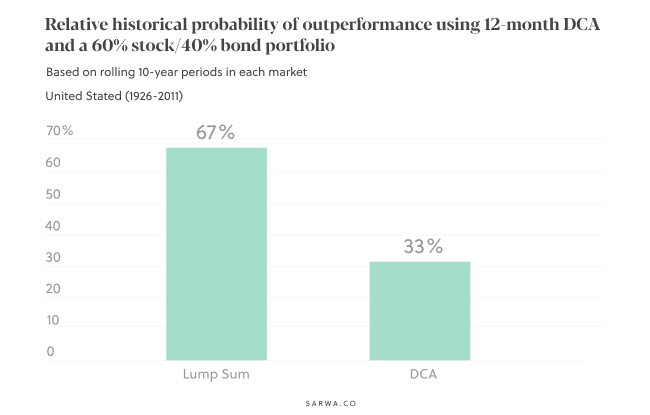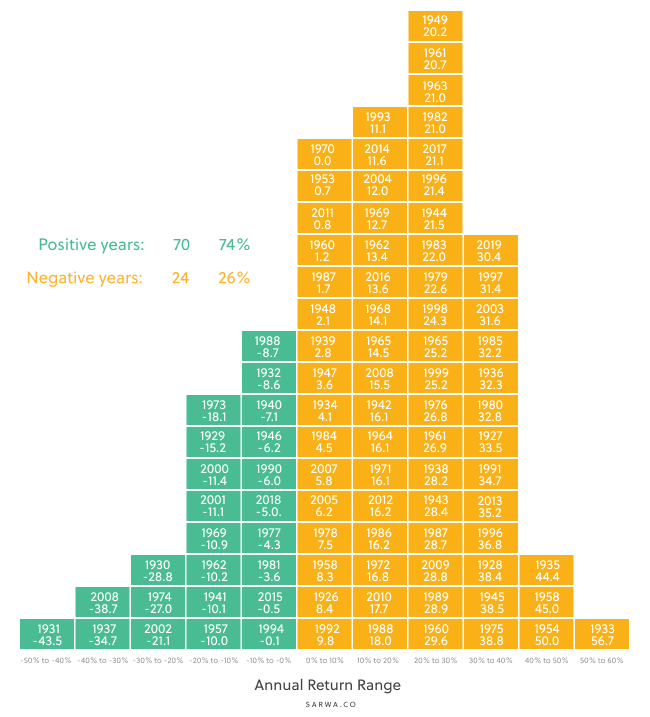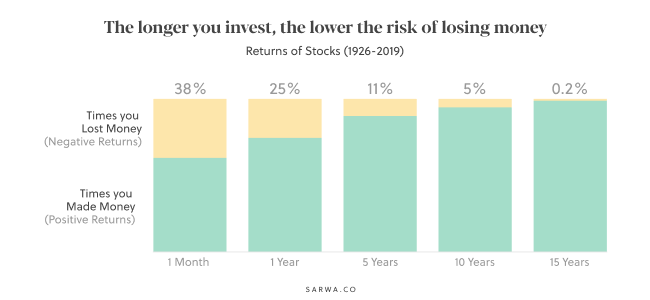The dollar-cost averaging vs. lump-sum investing debate is an important one for investors, especially when you find yourself wondering what to do with a larger and larger amount of hard-earned savings.
The premise of the debate goes: Should you invest all your money at once — or spread it out over a predetermined period?
This question often comes to the fore during periods of market volatility, most recently caused by economic recessions (as in 2008/2009) or a pandemic (2020).
But which investment strategy — dollar-cost averaging vs. lump sum — would help most when entering the market during such volatile periods?
While dollar-cost averaging (DCA) has its advantages (as we’ll discuss), lump-sum investing allows long-term investors to better maximise returns and minimise risks in a diversified portfolio.
A study by Vanguard found that with a 60/40 portfolio (60% stocks and 40% bonds), lump-sum investing outperformed dollar-cost averaging 67% of the time over 6 months and 92% of the time over a year.
This is because lump-sum investing helps you take advantage of the compounding effect right away — your money grows and multiplies immediately.
Similarly, lump-sum investing is the best when the market is rising, and the statistics show that the market rises more than it falls (74% to 26%, as we’ll cover more below). Also, when combined with diversification, lump-sum investing can also greatly minimise your risk exposure.
In this article, we’ll consider:
- What (exactly) is dollar-cost averaging?
- Why do investors employ dollar-cost averaging?
- What (exactly) is lump-sum investing?
- The case for lump-sum investing
- Dollar-cost averaging vs. lump-sum investing
- Diversification: A better way to reduce risk
1. What (exactly) is dollar-cost averaging?
There are several common misconceptions about dollar-cost averaging that unfortunately have made the rounds. Here, we need to dispel them.
The first thing to clarify is that the dollar-cost averaging strategy is not attempting to time the market.
Those that try to time the market work to predict the price movements of stocks. Historically, investors who time the market have had little success over the long run. A 2019 research by Dalbar Inc. shows that mutual fund investors who time the market have underperformed the market by 5% points over the previous 30 years.
There are also misconceptions about the exact definition of this strategy. We define it as such: Dollar-cost averaging is an investment strategy where an investor chooses (deliberately) to invest money available now (investable cash) over a predetermined period of time.
The key phrase above is “available now.”
If an investor invests every 25th of the month because that is his payday, that is not dollar-cost averaging.
Dollar-cost averaging is when an investor with $10,000 right here and now decides to invest it on the 25th of every month for the next six months rather than invest everything now.
2. Why do investors employ dollar-cost averaging?
Given proven levels of lower performance, why would any investor want to proceed with a DCA strategy?
There are several reasons why DCA has gained its current following.
A cautious strategy for volatile markets
During uncertain economic times, the market tends to become very volatile. This volatility can be intimidating.
For example, about 25% of all trading days in 2020 had price swings of 3% or more for the S&P 500. During the most volatile trading days, stock prices tend to fall fast, events that an emotional investor may not be able to stomach easily.
This is where dollar-cost averaging can help investors get more price stability in such market conditions, and it can be achieved by simply employing basic mathematics.
Let’s consider Investor A, who chooses to invest $120,000 in Vanguard S&P 500 ETF (VOO) over six months — that is $20,000 at the end of every month.
If the price of VOO continues to fall over that six months, Investor A will have more shares every new month than the previous month at the same price — $20,000. Investor A would end up acquiring more shares than if he/she spent the $120,000 at once.
Therefore, some investors believe dollar-cost averaging is the best investment strategy in uncertain economic times when the stock market is experiencing high volatility. As the prices fall, you can get more shares at the same price.
Dealing with the fear factor
Many investors who have trouble staying the course and keeping their emotions in check might prefer to spread out their investments over many months. In this way, spreading out investments is also equivalent to spreading out the emotional cost.
Similarly, investors who second-guess their investments can use dollar-cost averaging to “buy more time.” If you are not sure of an investment path, spending $20,000 over six months to test your strategy is better than spending $120,000 at once.
With the latter approach, you can quickly make a U-turn if you discover you are going the wrong direction. Investors who don’t want to invest too much too fast benefit from dollar-cost averaging in this way.
[For more on the emotional benefits of DCA, read “Dollar-Cost Averaging: Benefits For the Cautious Investor”]
3. What (exactly) is lump-sum investing?
Lump-sum investing is an investment strategy where an investor puts all his investable cash in the market immediately instead of investing it over a period of time. Following this definition, lump-sum investing then becomes the strategic opposite of dollar-cost averaging.
This means that if you choose to invest after receiving your monthly paycheck, you’ll be practicing lump-sum investing.
Someone who invests all of their investable cash at the end of every month is practicing lump-sum investing as much as the person who has $120,000 in his savings account and put it in the market at once.
The crucial differentiating factor is whether you invest all of your investable cash at once or over a period.
4. The case for lump-sum investing over dollar-cost averaging
The core advantage of lump-sum investing is that an investor can take advantage of compound interest.
For example, let’s reconsider Investor A. With the return on VOO at 18.35% over the last one year, we can use a monthly return rate of 1.5% (18.35%/12).
If investor A invests $20,000 at the end of January, he/she would have earned $300 at the end of February. On the other hand, if investor A invested $120,000, he/she would have $1,800 at the end of February.
With the former, investor A would have $20,300 to invest at the end of February; with the latter, $121,800.
The extra $1,800 will keep earning interest at a compound rate. After six months, investor A would have $131,213. If he/she had used dollar-cost averaging, he/she would have $124,591. On a purely accounting level, lump-sum investing makes more sense for higher performance.
As we mentioned, a now often-quoted study by Vanguard demonstrates that with a 60/40 portfolio of stocks and bonds, lump-sum investing outperforms dollar-cost averaging by 67% over six months and by 92% over twelve months.
Check out a chart from that study here:

But this study by Vanguard was only further proof of what was known as early as 1997. A report by Richard Williams and Peter Bacon showed that two-thirds of the time, $120,000 invested in the S&P 500 at the beginning of the year, outperformed $10,000 invested every month for 12 months.
A later study also compared lump-sum investing and DCA for fixed income securities rather than stocks. This dollar-cost averaging vs. lump-sum investing study also showed that lump-sum investing outperformed dollar-cost averaging about two-thirds of the time.
5. Dollar-Cost Averaging vs. Lump-Sum Investing
Above, we have seen that lump-sum investing is more profitable than dollar-cost averaging (return wise). Due to the mathematical magic of compound interest, you can expect to earn greater returns with lump-sum investing.
However, advocates of dollar-cost averaging still believe it’s a better approach for those investors looking to minimise risk exposure, especially in uncertain economic times.
It’s important to remember that this risk-minimisation benefit only applies if the market continues to go down. If the market goes up from when you start dollar-cost averaging, you will get less shares, and the strategy is thus less attractive.
Consider the example of VOO above. The price at the end of January was $295.69. Suppose it increased to $301 in February, $305.48 in March, $315.74 in April, $326.60 in May, and $350 in June.
Then, with DCA, you will have bought 67.6 shares in January, 66.4 shares in February, 65.5 shares in March, 63.3 in April, 61.2 shares in May, and 57 shares in June.
With the above scenario, you would have a total of 381 shares, which is less than the 405 shares you would have had with the lump-sum investing strategy.
Once again, the benefit of DCA only applies if prices continue to fall and the uncertain times last for the same period as your investment schedule.
The first problem with this is that experience has shown that the market rises more than it falls.
Let’s consider the below chart.

From 1926-2019, the market experienced only 24 negative years, while it experienced 70 positive years, according to data from the Center for Research in Security Prices at the University of California.
Put simply and matter of factly: “The market tends to go up more than it goes down,” says Kristin McKenna, Senior Contributor at Forbes.
“The pandemic just ended the longest bull market in history. If you had dollar-cost averaged over the last several months of 2019 instead of the beginning of 2020, the $10,000 investment would likely have bought you fewer and fewer shares each month. Which brings up another risk: that the market only goes up during your investment period.”
If the market only goes up in your investment period, the advantages of DCA erodes. And since this is what happens more often than not (74% to 26%), dollar-cost averaging is not as advantageous as its proponents claim.
“People do dollar-cost averaging because they have regret from making one big mistake,” said Kenneth Fisher, an American billionaire and investment analyst. “But the fact of the matter is that, mathematically, the market rises more of the time than it falls. It falls, but it rises more of the time than it falls.”
Secondly, though dollar-cost averaging is different from timing the market, it often turns out to be a thin line. If DCA is only favourable when the market keeps going down and that advantage erodes when it is rising, investors may end up trying to predict whether the market will have a rebound or keep falling to make a decision.
The end result, whatever the intentions are, is market timing, that vice most dangerous to the investing life.
Thirdly, for long-term investors, the ability to predict if a downturn lasts or a rebound is on the way is practically useless. What matters is that in the long term, the market grows and gains value. Long-term investors are willing to endure the short term fluctuations and volatility for the long-term returns.
In fact, the longer you stay in the market, the lesser the risk of experiencing negative returns and the higher the possibility of enjoying positive returns, vice versa. Research by Morning Star shows that if you stayed in the market for 1 month, you would have gained money 62% of the time and lost it only 38% of the time. If you are invested in the market for 5 years, you would have made money 95% of the time and only lost it 5% of the time.
The longer you are invested, the less likely you would lose money. More reason why dollar-cost averaging is irrelevant to long term investors.

Consequently, while dollar-cost averaging can lead to market timing mentality, lump-sum investing fosters long-term investing, the right approach and attitude for those who want to build wealth.
6. Diversification: a better way to reduce risk
No matter which strategy is employed, diversification remains the best way to reduce overall risk. You can diversify your investments by industry (technology, finance, industrials, for example), market capitalisation (large cap, medium cap, small cap), and geography (developed, emerging, for example).
When you diversify in a set of assets that are not positively correlated, the risk of your overall portfolio becomes less than the risk of any asset in the portfolio. In this way, the rise in the value of one asset can compensate for the fall in the other since they are not positively correlated.
This is how diversification reduces portfolio risk by minimising your risk exposure.
[Learn more about the power of diversification here: Why Not Only Invest in the S&P 500? Lessons in Diversification]
No matter the market condition, diversification has proven to be the all-weather strategy to reduce risk.
This is why, instead of using dollar-cost averaging, the experts have long pointed towards embracing lump-sum investing (so you can maximise your returns) by building a diversified investment portfolio (so you can minimise your risk).
Sarwa helps investors achieve both objectives by providing a diversified portfolio that matches your risk tolerance level.
Our wealth building team will work to understand your risk tolerance, create a diversified portfolio for you through the Modern Portfolio Theory, and then set up an automatic rebalance for your portfolio through our investment platform.
[To learn more, read “Where to Invest $100k: A Smart Strategy For the “Future You”]
Takeaways
- Lump-sum investing has been proven to generate better returns than dollar-cost averaging.
- When comparing dollar-cost averaging vs lump-sum investing, DCA only has an advantage when the stock market continues to fall for a long period. However, the stock market rises more than it falls.
- DCA has emotional benefits for those cautious investors who can’t put all their feet in the water at once. However, such cautiousness is unnecessary for long-term investors.
- The best way to reduce risk in normal and uncertain times is portfolio diversification.
